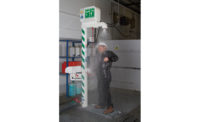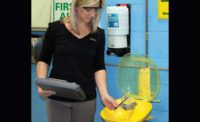The International Safety Equipment Association (ISEA) produces the American National Standard for Emergency Eyewash and Shower Equipment, ANSI Z358.1, to establish uniform minimum performance and use requirements. The standard is a comprehensive outline that serves as a guideline for companies and safety professionals to provide safe working environments.
By applying a few additional best practices, you can exceed the minimum response requirements and ensure that each site implements and manages appropriate emergency response systems, minimizing related employee injuries and preventing a crisis situation from going from bad to worse.
At any moment
The hope may be that you’ll never have to use your emergency equipment, but still you should maintain the mindset that an emergency could happen at any moment. When a victim needs an eyewash or shower, you must have confidence that your eye or facewash is working properly to provide the care that is needed.
A safety industry survey1 asked professionals who make product recommendations and/or buying decisions what they considered the most important considerations when selecting an eyewash and/or eyewash/shower combination unit. Not surprisingly, the top two answers were ANSI compliance and victim comfort. Put yourself in a victim’s shoes when making a purchasing decision and you are most likely to purchase equipment that not only meets the ANSI standard, but provides the most critical care during an emergency.
Beyond the purchase of emergency eyewash and/or eyewash/shower combination units, it is critical to ensure that the equipment is functioning properly and highly visible in case of an emergency. Based on a sample of independent third-party testing and review it was found that while all sites believed they were in compliance, 75 percent of equipment tested was non-compliant for both minor and significant violations.2 Below are five best practices when purchasing, placing, and maintaining your emergency equipment.
1) Product specification & placement
When it comes to emergency response equipment, there is no shortage of available products. With so many choices – oftentimes differentiated only by subtle differences – it’s important to critically assess specific risks to determine the most suitable product. For example, in a chemical plant where liquids form the general risk an eye/face wash would be the most appropriate choice.
Location should be the next critical consideration. Per ANSI, emergency equipment must be located on the same level and within an unobstructed, 10-second walk from a potential hazard (roughly 55 feet). The number of showers/eyewashes available and their individual locations must be evaluated when determining installation locations.
2) Proper visibility
High visibility of safety equipment can be achieved with clear signage, proper lighting and the use of the color known as “safety green.” This color is used industrially to designate both the concept of safety and the physical locations of first aid and emergency response equipment, including drench showers and eyewashes. ANSI Z535.1 takes this one step further by providing a standard for color schemes, sizing, meaning and application for various workplace hazards.
3) Tepid water
Excessively hot- or cold-water temperatures in safety showers and eyewashes can exacerbate the very injuries the safety equipment is designed to reduce. In the 2009 revision of ANSI Z358.1, the standard outlines suitable water temperatures as tepid, defined as a range between 60˚ and 100˚ F (15.5˚ to 37.77˚ C). It also specifies a full 15-minute drench or irrigation cycle, a length of time that must be considered with the victim in mind.
An uncomfortable victim will be less inclined to abide by the flush requirements, which could worsen an injury. By selecting a suitable mixing valve and defining a tepid water range that is more comfortable to the user, you are not only encouraging the full flush period but also increasing the likelihood that a victim will remove contaminated clothing, which further enhances the wash objective.
4) Continuous maintenance & testing
One of the implied responsibilities of specifying and installing emergency equipment is assuring a maintenance process designed to keep safety showers, eyewashes and associated system components functioning optimally.
A common question relates to the appropriate length of time for unit testing. While a quick activation to test the unit might seem sufficient, it is more valuable to test each unit for the required 15-minute flush every time. The intention behind routine testing is to guarantee that each piece of equipment has the proper flushing fluid supply and flow, to clear the line of any sediment build-up and to minimize contamination related to inactive water.
Testing should replicate a real-life scenario to ensure that each site can be confident in the emergency unit’s ability to reliably perform.
5) A robust safety culture
This may be the most important overarching aspect of what we do in the safety industry, yet it is not covered as thoroughly as it should be. The key is to developing a strong safety culture and understanding the risks of noncompliance. In 2016, OSHA increased its penalties by 80 percent and that rate continues to increase annually based on the Consumer Price Index yearly percentage increase.3 Consider the OSHA penalty hike a boon for workplace safety. Studies have shown that workplace injuries are reduced in settings in which health and safety inspections have direct consequences for violations.
By building a strong safety culture, management is aware of the risks of noncompliance from both a financial and HR perspective. By understanding the “why” behind choosing the right equipment, the right placement, the right environment, and the importance of proper maintenance, could reduce costs and, in the end, could save a life.
Sources
1. 2014 Independent research survey, Haws Corporation
2. Based on results from Haws Site Survey Program
3. OSHA fines to increase significantly. (2015, November 5) Retrieved from http://www.safetyandhealthmagazine.com/articles/13258-osha-fines-to-increase-significantly



